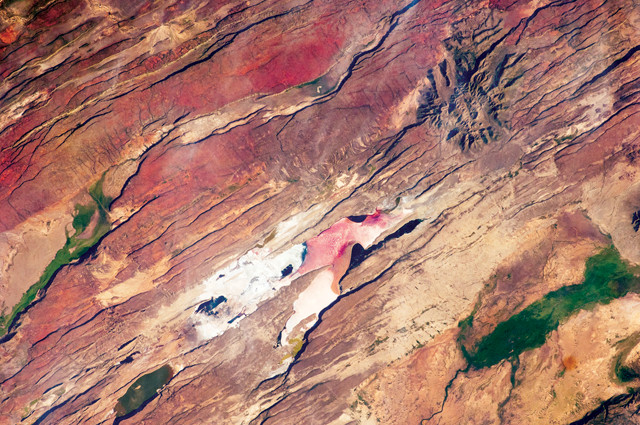
by Mary Caperton Morton Wednesday, March 14, 2018

Part of the East African Rift, the largest continental rift on Earth today, in southern Kenya as seen from the International Space Station in 2012. Many of the linear features running from the bottom-left (north) to top-right (south) are scarps formed by faulting associated with the rift. Credit: NASA.
The vast majority of Earth’s carbon is stored in the planet’s interior. This buried carbon is not isolated from the surface over geologic timescales, however; some of it is released back into the atmosphere as carbon dioxide and other gases when volcanic eruptions occur above subduction zones or island arcs. In a couple of new studies, researchers have identified another major component in the global carbon cycle: continental rift faults. Such faults, like those found along the East African Rift today, may contribute even more carbon dioxide to the atmosphere at times than volcanoes.
The East African Rift, where the African Plate has been splitting apart over the past 22 million years, is one of the most dramatic geologic settings on Earth today. But this 6,000-kilometer-long rift is small in comparison to the scale of rifts in Earth’s past. “When Pangea was breaking apart about 130 million years ago, a network of rift systems formed with a total length of more than 40,000 kilometers,” says Sascha Brune, a geodynamicist at the GFZ German Research Center for Geosciences in Potsdam and lead author of one of the new studies, published in Nature Geoscience.
To study how continental rifting may have contributed to the global carbon cycle in the past, Brune and his colleagues reconstructed how the global rift network has evolved over the past 200 million years. They identified two significant episodes of rifting around 130 million and 50 million years ago when rift systems stretched for more than 30,000 kilometers across what is now the Americas, Asia and Africa. Using numerical carbon cycle models, the team showed that both of these periods of rifting correlated with higher atmospheric carbon dioxide concentrations, as copious amounts of carbon dioxide are released along rifts through degassing of carbon-enriched lithosphere.
In a separate study also in Nature Geoscience, Stephen Foley of Macquarie University in Australia and Tobias Fischer of the University of New Mexico quantified the amount of carbon dioxide that could be released by major continental rifting episodes. “Before the first studies came out in 2016” — by Hyunwoo Lee of the University of New Mexico and colleagues — “we knew almost nothing about carbon dioxide emissions from rifts,” Fischer says. “We knew volcanoes could produce a lot of carbon dioxide, but we had almost no measurements from rifts.”
Foley and Fischer used insights from geochemistry and thermodynamics to calculate the carbon storage potential of the continental lithosphere and show how carbon is concentrated along rift centers by low-temperature remelting over geologic time. During rifting episodes, this stored carbon is then released through degassing.
“Remelting [of lithosphere] focuses carbon beneath rifts, creating zones with about 150 to 240 megatons of carbon per cubic kilometer, explaining the well-known association of carbonate-rich magmatic rocks with rifts,” the team wrote. “Reactivation of these zones can release 28 to 34 megatons of carbon per year for the 40-million-year lifetime of a continental rift.” But when supercontinents like Pangea broke up in the past, the increased rifting associated with the breakup “could have led to short-term carbon release of at least 142 to 170 megatons of carbon per year, and may have contributed to the high atmospheric carbon dioxide at several times in Earth history,” the team wrote. Brune and colleagues, meanwhile, found that during the past episodes of supercontinent breakup they modeled, massive rift networks released as much as 200 megatons of carbon per year.
Previous field studies of gas emissions at the East African Rift have estimated that it produces about 19 megatons of carbon dioxide each year. In comparison, the U.S. Geological Survey estimates that the world’s volcanoes generate about 260 megatons of carbon dioxide annually, while anthropogenic activities produce roughly 100 times that — upwards of 32 gigatons of carbon dioxide emissions every year.
The new studies have some sobering lessons for modern carbon dioxide emissions, Fischer says. “Anthropogenic emissions are higher by several orders of magnitude than natural emissions, even when we include massive features like the East African Rift,” he says. “If that kind of rifting had an impact on climate in the past, it’s pretty clear that our much greater anthropogenic emissions will also affect climate in the future.”
Several other recent studies have also revealed surprisingly large reservoirs of magma in rift fault systems where magma was not previously thought to exist, says Cynthia Ebinger, a geophysicist at Tulane University in New Orleans who was not involved in either of the Nature Geoscience papers. For instance, Ebinger says, in 2017, in Malawi, Kenya and Tanzania, “we discovered large amounts of carbon dioxide emissions coming up from fault systems at great distances from volcanoes. Prior to those discoveries, we all assumed that carbon dioxide emissions were centered around volcanoes,” but it seems that the rifts and faults between the volcanoes also play an important role.
The two Nature Geoscience papers mark a first attempt at quantifying the role of rifting in the global carbon cycle over geologic timescales, she says. “I think the Fischer and Foley paper will prove to be one of those classic papers that revises the way we think about the global carbon cycle and continental dynamics,” she says. The Brune paper is also “rigorous and provocative” and should inspire some interesting follow-up studies about the carbon dioxide contributions of modern-day rifts.
© 2008-2021. All rights reserved. Any copying, redistribution or retransmission of any of the contents of this service without the expressed written permission of the American Geosciences Institute is expressly prohibited. Click here for all copyright requests.